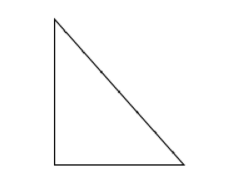
How do you use the law of cosines to find BC given a triangle ABC with angle $A = 93,\,AC = 17$ and $AB = 28$?
Answer
538.2k+ views
Hint: First we will draw a rough diagram. Then mention all the given terms and their respective values. Then use one of the forms of Laws of Cosines. Then substitute the values of the terms and simplify the terms to evaluate the value of the side BC.
Complete step by step solution:
We will first draw a rough diagram.

$\angle A$ is unchanged which is $93$.
Side AC becomes side $b$ which has the value $17$.
Side AB becomes side $c$ which has the value $28$.
Side BC becomes side $a$ whose value is unknown.
The one of the three forms of the Law of Cosines that we need is:
${a^2} = {b^2} + {c^2} - 2(b)(c)\cos (A)$
Now, we will substitute all the given values.
${a^2} = {17^2} + {28^2} - 2(17)(28)\cos ({93^0})$
Now, we solve for the value of $a$.
${a^2} = {17^2} + {28^2} - 2(17)(28)\cos ({93^0})$
Hence, the value of the side BC is $33.5$.
Additional information: Inverse trigonometric functions are simply defined as the inverse functions of the basic trigonometric functions which are sine, cosine, tangent, cotangent, secant and cosecant functions. They are also termed as arcus functions, anti-trigonometric functions or cyclometric functions.
Note: While using the different forms of Laws of Cosines choose according to the given and required terms. Substitute the terms in the equation cautiously. While modifying any identity make sure that when you back trace the identity, you get the same original identity.
Complete step by step solution:
We will first draw a rough diagram.

$\angle A$ is unchanged which is $93$.
Side AC becomes side $b$ which has the value $17$.
Side AB becomes side $c$ which has the value $28$.
Side BC becomes side $a$ whose value is unknown.
The one of the three forms of the Law of Cosines that we need is:
${a^2} = {b^2} + {c^2} - 2(b)(c)\cos (A)$
Now, we will substitute all the given values.
${a^2} = {17^2} + {28^2} - 2(17)(28)\cos ({93^0})$
Now, we solve for the value of $a$.
${a^2} = {17^2} + {28^2} - 2(17)(28)\cos ({93^0})$
Hence, the value of the side BC is $33.5$.
Additional information: Inverse trigonometric functions are simply defined as the inverse functions of the basic trigonometric functions which are sine, cosine, tangent, cotangent, secant and cosecant functions. They are also termed as arcus functions, anti-trigonometric functions or cyclometric functions.
Note: While using the different forms of Laws of Cosines choose according to the given and required terms. Substitute the terms in the equation cautiously. While modifying any identity make sure that when you back trace the identity, you get the same original identity.
Recently Updated Pages
Master Class 12 Economics: Engaging Questions & Answers for Success

Master Class 12 Maths: Engaging Questions & Answers for Success

Master Class 12 Biology: Engaging Questions & Answers for Success

Master Class 12 Physics: Engaging Questions & Answers for Success

Master Class 8 Maths: Engaging Questions & Answers for Success

Class 8 Question and Answer - Your Ultimate Solutions Guide

Trending doubts
What is meant by exothermic and endothermic reactions class 11 chemistry CBSE

Which animal has three hearts class 11 biology CBSE

10 examples of friction in our daily life

One Metric ton is equal to kg A 10000 B 1000 C 100 class 11 physics CBSE

1 Quintal is equal to a 110 kg b 10 kg c 100kg d 1000 class 11 physics CBSE

Difference Between Prokaryotic Cells and Eukaryotic Cells




